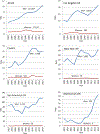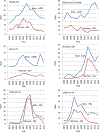Syphilis in the United States: on the rise?
- PMID: 25487961
- PMCID: PMC6750765
- DOI: 10.1586/14787210.2015.990384
Syphilis in the United States: on the rise?
Abstract
Syphilis rates and trends vary by population subgroup. Among men who have sex with men (MSM), rates of primary and secondary (P&S) syphilis are high throughout the USA (228.8 per 100,000 in 2013). P&S syphilis among women is much less common (0.9 per 100,000 in 2013) and occurs in isolated outbreaks plus in a few counties with persistent low levels of infection. Congenital syphilis trends closely follow P&S trends among women. These trends have implications for prevention. Routine screening among MSM can prevent tertiary syphilis, but despite interventions, rates of infection continue to rise among MSM and will soon approach those last seen in 1982 (estimate: 340.7 per 100,000). Control of syphilis among women is possible and important because it often leads to congenital syphilis. Outbreaks among heterosexuals can be halted by intensive screening, treatment and partner notification.
Keywords: congenital syphilis; epidemiology; men who have sex with men; prevention; surveillance; syphilis.
Figures






References
-
- Centers for Disease Control and Prevention. Sexually Transmitted Disease Surveillance 2012 Atlanta: U.S. Department of Health and Human Services; 2013, pp 79–80.
-
- Centers for Disease Control and Prevention. The national plan to eliminate syphilis from the United States. 1999 Available at http://www.cdc.gov/stopsyphilis/Plan.pdf.
-
- Centers for Disease Control and Prevention. Primary and secondary syphilis—United States, 1999. MMWR 2001;50:113–117. - PubMed
-
- Centers for Disease Control and Prevention. Sexually transmitted diseases treatment guidelines, 2010, MMWR 2010;59(no.RR-12) pp. 26–36. - PubMed
Publication types
MeSH terms
Supplementary concepts
Grants and funding
LinkOut - more resources
Full Text Sources
Other Literature Sources
Medical
